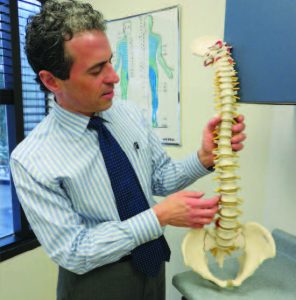Does your pain need an intervention?
Aside from cold, flu and upper respiratory conditions, the most common reason people see a doctor is due to neck and lower back pain. The causes of neck and back pain can vary greatly. Some are attributable to repetitive injuries, but more commonly the pain is traceable to a single event, such as bending or lifting, or something more direct, for example a fall. Sports injuries are also a very common source of neck or back pain, as are impacts from motor vehicle accidents.
Most neck and back muscle sprains will resolve spontaneously, or with conservative treatments. Patients whose pain persists may seek out stronger pain medication from their primary physicians, and go for various therapies such as massage, physical therapy, chiropractic treatment or acupuncture. These injuries typically resolve within several months of the accident.
But what if they don’t?
If the condition persists despite several months of conservative therapy, then interventional pain management is the logical next step. The goal of interventional pain management is to diagnose and treat the condition with the simplest and least number of treatments possible. Of the patients I see, over 95 percent will improve from these interventions; only a handful will ever need conventional surgery.
Your first visit to an interventional pain management practice involves the taking of a comprehensive history and an in-depth physical examination. Most patients I see have already had an MRI done, which I will review. If it turns out you have not undergone appropriate conservative treatment, then that will be recommended. The focus of the initial visit is aimed toward forming an accurate diagnosis, and from there a discussion of the most likely causes of the condition and the best treatment options.
Tools of the Trade
The mainstay of treatments that interventional pain physicians perform is diagnostic and therapeutic nerve blocks or epidural injections. Once I’ve formed a diagnostic impression, I utilize these interventional therapies to confirm it and treat the condition. Pain physicians use the term “the pain generator” to describe the structure that ultimately is determined to be the origin of the pain. Sometimes it is obvious, but other times it is not. These “tools”—the diagnostic nerve blocks—can help determine if any particular structure is producing the condition.
After the nerve block injection, the patient returns a week later to report on any progress or changes. I instruct patients to keep a diary on how they felt on Day 1, Day 2 and so on. If they report that they felt very little or no pain for a time after the nerve block, then it is very likely that structure is the source of what’s causing the pain. Basic interventions, such as nerve blocks or epidural injections, are the first line of therapy. Once the cause of the condition has been identified, if necessary, more definitive treatments can be performed such as nerve ablation or percutaneous disk decompression procedures. Some patients will be cured outright, and most will achieve sustained pain relief for an extended period of time.
MRIs are an important part of the evaluation, but they often don’t tell the whole story. In many cases, the patients that interventional pain practices see have already been to multiple doctors and received multiple opinions on causes and treatments. More times than not, the actual origin of the pain is not immediately obvious. A phrase I say a lot is that it’s normal to be abnormal—meaning that most patients will not have a MRI study that is completely normal. Most people exhibit some degree of disk degeneration, disk bulging or other abnormalities on their MRIs, because frankly disk degeneration begins at around 30 years of age for everyone. This is true even if they have never had any back pain. So I can’t automatically assume that abnormalities on the MRI are a true indication of what’s causing the pain.
 I’m In Agony…What Now?
I’m In Agony…What Now?
The most common neck and back injuries are sprains and strains—in other words, some type of muscle injury. Most initial injuries are treated similarly: rest, ice application (within the first 24 to 48 hours) and anti-inflammatory medications (NSAIDS). More severe neck and back injuries can involve the disks in the neck and back, nerves, joints and even bones (fractures).
The severity of an injury dictates whether or not you need to seek immediate medical attention. If the injury causes a significant limitation in function (standing, bending, walking, etc.), then it is advisable to be seen by a doctor ASAP.
A Feel for Pain
There are two main components of being a good interventional pain specialist. The first is being a good diagnostician (this is the art part), and the second is being a good injectionist. The latter involves the precision and technique required to perform the nerve block, or whatever treatment is being done. Treatment is an ongoing, dynamic situation. My over 16 years of experience has certainly improved both aspects of my care. Evaluating the results of one treatment, and from there forming a treatment plan leading to permanent relief, is paramount to being a good interventional pain management physician.
Patients usually ask me how many treatments they will need. Most patients only need a few treatments. I would say that 25 to 30 percent who undergo a single treatment return reporting so much relief from their pain that they are basically cured. Most of the remaining patients require two or three treatments to achieve benefit; unfortunately, there is no way to predict when someone walks through the door how many treatments he or she will require. Then, of course, you have those stubborn conditions, which require a more aggressive level of interventional care. What I say to most patients is that it’s not whether they are going to get better, just a matter of how many treatments and what level of therapy they will require.
 There are, of course, conditions we see where we know right away that a cure is not possible. One such condition is when there is permanent nerve injury. In such cases, the goal is palliative care, to relieve as much of the pain and improve as much of the function as possible, using various interventional techniques and other modalities.
There are, of course, conditions we see where we know right away that a cure is not possible. One such condition is when there is permanent nerve injury. In such cases, the goal is palliative care, to relieve as much of the pain and improve as much of the function as possible, using various interventional techniques and other modalities.
Lastly, there are of course some patients whose condition is beyond what interventional treatment can offer and do need surgery. Even so, undergoing a good “pain workup” can improve surgical outcomes because, at the point where someone is referred for surgery, we have already ruled out a good number of possible causes—and most times determined the precise condition that needs surgical intervention.
A need has always existed for a focused discipline that can monitor, diagnose and treat patients with pain-producing conditions. Pain is one of the most common reasons people visit their doctor, and at some point many of those patients will find themselves in need of a specialist who can manage and direct them to the most appropriate course of treatment. The field of interventional pain management actually originated as a subspecialty of anesthesiology. It makes sense if you think about it—anesthesiologists, after all, are doctors who specialize in rendering patients pain-free during surgery and childbirth. The field has grown substantially over the last two-plus decades, and physicians now enter from other fields, including physical medicine, rehabilitation and neurology.
 My MRI shows a disk herniation, do I need surgery?
My MRI shows a disk herniation, do I need surgery?
The take home message here is to always go from a conservative to a more aggressive course of treatment.
If you haven’t gone through a course of physical therapy, you must. Medications such as anti-inflammatories and muscle relaxants can also be beneficial. If symptoms persist, you need to get a comprehensive physical examination. Remember that MRI findings do not tell the whole story. While the most common type of spine injuries involve disk herniations, injuries can also involve the joints and other supportive structures which make up the spine.
If the disk herniation is shown to be the cause of the condition, you may be a candidate for a type of minimally invasive pain interventional therapy, which have fewer possible complications and a shorter recovery time.
When is it time to seek out professional help?
Listen to your body. If you have suffered an injury, you should not do things that exacerbate the pain. Some rest (but not too much) is important—ignoring the pain can sometimes lead to permanent and devastating disability. If the pain has not resolved quickly, seek medical care so that you can be evaluated and begin a course of conservative therapy.
Also, know that—when conservative treatment strategies don’t solve the problem—there are doctors who specialize in getting to the bottom of the pain. Again and again, I see patients who have waited months (or even years) before seeking interventional pain treatment. What I have learned from them is that, unfortunately, the longer a condition has persisted, the more difficult it can be to treat. Interventional pain management is not for everyone, of course, but the benefits greatly outweigh the risks in most cases. At the very least, any patient who is still experiencing pain after several months of conservative therapy—and is not improving—should be evaluated for the appropriateness of interventional therapy. The most important rule of thumb is to begin treatment with conservative therapies, and work your way up from there.
 Editor’s Note: Dr. Todd Koppel is a board-certified pain specialist and
Editor’s Note: Dr. Todd Koppel is a board-certified pain specialist and
anesthesiologist, and Division Chief of Pain Management at Trinitas
Regional Medical Center. The variety of conditions he treats and the
techniques he utilizes can be found on his website, gspmweb.com. His practice, Garden State Pain Management, has offices in Clifton, Elizabeth and other New Jersey locations. Dr. Koppel can be reached at (973) 473-5752.





